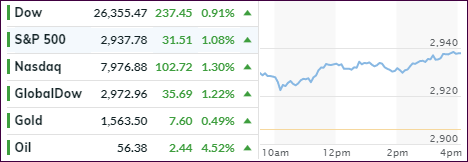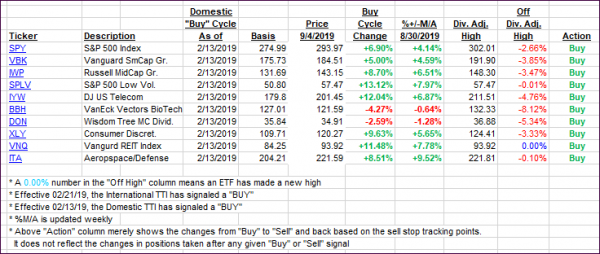
- Moving the markets
The major indexes staged a turnaround, after yesterday’s pullback, encouraged by an apparent ease in Hongkong tensions. Chief executive Carrie Lam announced that she would withdraw the controversial extradition bill that has sparked months of violent protests, which were feared to eventually hurt the business climate and global financial markets.
While this bill meets only one of five demands from the protesters, at least it’s a step in the right direction, which put the computer algos into a buying frenzy and spreading a sea of green in equities.
Also helping the bullish mood were reports that the People’s Bank of China will soon implement cuts in reserve requirements for Chinese banks, a move that is expected to boost growth and shows willingness by the government to battle the effects of higher US tariffs on Chinese imports.
This readiness by the Chinese to engage in some sort of stimulus eased fears, at least for the moment, that the US economy might slide into a recession in part due to the endless US-China tariff conflict, which has been a contributing factor to not just a worldwide disruption of supply chains but too a slowdown of global economies.
Likewise giving an assist to the bullish cause was more dovish encouragement from a variety of Fed speakers that rate cuts are on the menu. ZH summed them up as follows:
Williams (Dovish): “Ready to act as appropriate”, July cut was right move, economy mixed (admitted consumer spending not a leading indicator), international news matters, low inflation biggest problem.
Kaplan (Dovish): “Monetary policy a potent force”, worried about yield curve inversion, economy mixed (factories weak due to trade, consumer strong), watching for “psychological effects” on consumers, “if you wait for consumer weakness, it might be too late.”
Kashkari (Dovish): Tariffs, “trade war are really concerning business”, job market not overheating, slower global growth will impact US, most concerned about inverted yield curve. Fed’s policy is “moderately contractionary.”
Bullard/Bowman (Looked Dovish): Took part in “Fed Listens” conference but made no comment on policy but then again when has Jim Bullard ever not been dovish.
Beige Book (Mixed): Moderate expansion but trade fears are mounting, but optimism remains, despite what Kashkari says: “although concerns regarding tariffs and trade policy uncertainty continued, the majority of businesses remained optimistic about the near-term outlook”
Evans (Dovish): Trade policy increases uncertainty and immigration restrictions lower trend growth to 1.5%, Auto industry especially challenged
As a result, the markets have now ‘priced in’ an astonishing 124 bps (1.24%) of rate cuts through the end of 2020. Tip of the hat goes to ZH for this chart. On the other hand, a trade deal is now almost entirely ‘priced out,’ which means that the only ‘big dog’ left to support equities is none other than the Fed and its policies.
2. ETFs in the Spotlight
In case you missed the announcement and description of this section, you can read it here again.
It features 10 broadly diversified and sector ETFs from my HighVolume list as posted every Saturday. Furthermore, they are screened for the lowest MaxDD% number meaning they have been showing better resistance to temporary sell offs than all others over the past year.
The below table simply demonstrates the magnitude with which some of the ETFs are fluctuating regarding their positions above or below their respective individual trend lines (%+/-M/A). A break below, represented by a negative number, shows weakness, while a break above, represented by a positive percentage, shows strength.
For hundreds of ETF choices, be sure to reference Thursday’s StatSheet.
For this current domestic “Buy” cycle, here’s how some our candidates have fared:

Again, the %+/-M/A column above shows the position of the various ETFs in relation to their respective long-term trend lines, while the trailing sell stops are being tracked in the “Off High” column. The “Action” column will signal a “Sell” once the -8% point has been taken out in the “Off High” column. For more volatile sector ETFs, the trigger point is -10%.
3. Trend Tracking Indexes (TTIs)
Our Trend Tracking Indexes (TTIs) surged with the International one now touching its long-term trend line. I need to see more of a piercing to the upside, along with some staying power, before declaring a new ‘Buy’ for that arena.
Here’s how we closed 09/04/2019:
Domestic TTI: +2.99% above its M/A (prior close +1.78%)—Buy signal effective 02/13/2019
International TTI: +0.09% above its M/A (prior close -1.11%)—Sell signal effective 08/15/2019
Disclosure: I am obliged to inform you that I, as well as my advisory clients, own some of the ETFs listed in the above table. Furthermore, they do not represent a specific investment recommendation for you, they merely show which ETFs from the universe I track are falling within the specified guidelines.
Contact Ulli